Paradise Themes-A Hypothesis
PARADISE THEMES - A HYPOTHESIS
by Diane E. Wirth
Deriving from the Paradise saga of the Old Testament and the Popol Vuh creation story of the Quiché Maya of Guatemala and other oral traditions, there developed beliefs in a location that had certain qualifications as the center of the earth, or the axis mundi. This paradisiacal locale was called Eden from several texts that came out of the Old World, and due to the many languages used in the New World (more particularly, Mesoamerica), there were various names for this sacred place of origin. Ancient cultures around the world regarded their people as significant, that the location where they lived was sacred and the center of the earth. Many believed that the creation of the earth started in their realm. Most Biblical scholars uphold the idea that the Garden of Eden was literally located in the Middle East. Going across the sea to the Western Continent, the New World, we find two outstanding locations that are proposed as Paradise at the beginning of creation. Members of The Church of Latter-day Saints are familiar with the location that the prophet Joseph Smith claimed to be the spot as revealed to him: Jackson County, Missouri (DC 57:1-3; 84:1-3). But, as we will see, many cultures of Mesoamerica believed they also had this paradisiacal setting in their midst. Was it because their ancient prophets talked of this primordial paradise? Did future generations want to duplicate this sacred location that took place at the time of the creation of the world? The Book of Mormon certainly testifies of prophets speaking to their people of the Garden of Eden (books of 2 Nephi and Alma). The Nephites were also in possession of the Brass Plates from Jerusalem that contained the story of the creation and Paradise, but not all the specific details are given in the portions translated for us in the Book of Mormon.
Rivers Extending out to the Cardinal Directions
Many Gothic cathedrals of Europe have murals or mosaics of Paradise depicting four rivers emerging 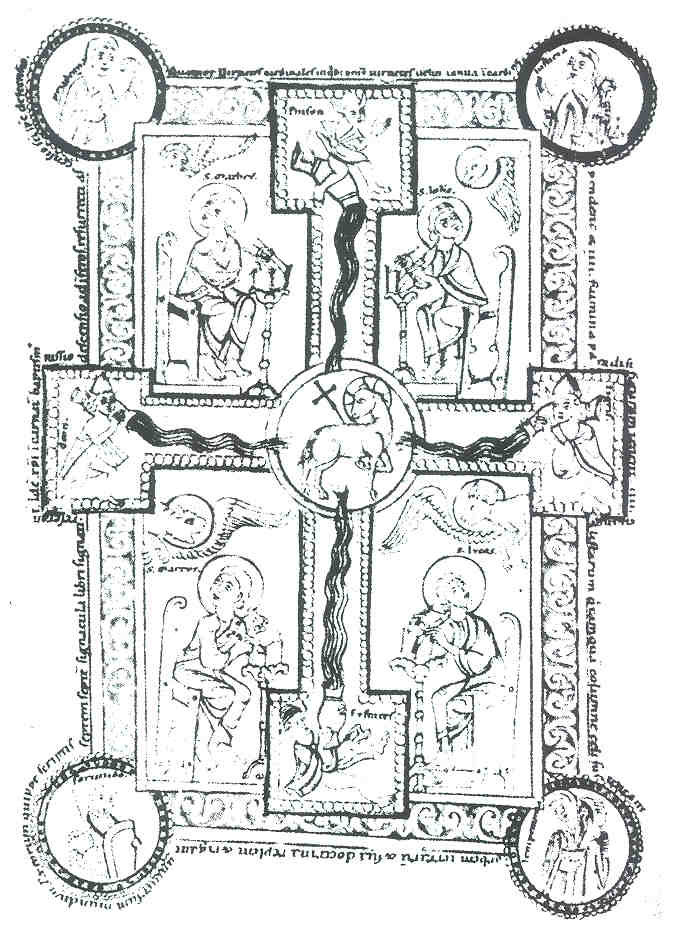 from a central point, which could be a fountain, the Tree of Life, or another sacred object. One example from the Zwiefalten Monastery in Germany has the Lamb of God at the center (see Figure 1). Jesus Christ is considered the Lamb of God and the Tree of Life. The rivers this particular illustration branch out to the four directions of the Cardinal Points. This ideology became symbolic of the ‘Center’ and of the ‘Origin’ of all things. The theme of the four rivers of Paradise was a popular decoration of churches in the early Byzantine period. According to Genesis (2:10-14), a river flowed out of Eden and then divided into four major rivers: the Pison or Pishon, the Gihon, the Hiddekel, and the Euphrates (a.k.a. Perat). Scholars believe these four directional rivers represented the four quarters of the inhabited world.
from a central point, which could be a fountain, the Tree of Life, or another sacred object. One example from the Zwiefalten Monastery in Germany has the Lamb of God at the center (see Figure 1). Jesus Christ is considered the Lamb of God and the Tree of Life. The rivers this particular illustration branch out to the four directions of the Cardinal Points. This ideology became symbolic of the ‘Center’ and of the ‘Origin’ of all things. The theme of the four rivers of Paradise was a popular decoration of churches in the early Byzantine period. According to Genesis (2:10-14), a river flowed out of Eden and then divided into four major rivers: the Pison or Pishon, the Gihon, the Hiddekel, and the Euphrates (a.k.a. Perat). Scholars believe these four directional rivers represented the four quarters of the inhabited world.
In The Legends of the Jews, Louis Ginzberg writes of waters flowing beneath the
Tree of Life in Eden, which irrigated the whole earth. He has determined, along with other scholars, the four rivers referred to are the Ganges, the Nile, the Tigris, and the Euphrates.1 However, the identification of these rivers vary among scholars, and what we know of modern rivers of the Old World do not have an exact match with the configuration in Genesis, albeit there was a change of land mass in the days of Peleg (Gen. 10:25).
These four rivers of Eden have also been seen in traditions of the Scandinavians, the Chinese, the Mesopotamians, the Tibetians, and the Buddists as well as several other cultures.2 If we look at Joseph Smith’s model, perhaps these four rivers refer to the Mississippi, Missouri, Ohio and the Illinois, or other rivers that would have existed in those days that have changed when the topography was altered as we now know it. Milton R. Hunter remarked that “It is very evident that since the river that ran through Ethiopia (Nile) and the Euphrates River are hundreds of miles apart, they could never have been joined together . . . the Mississippi River and its tributaries fit well with the description given in Genesis and in the Book of Moses.”3
In the Guatemala Highlands there is an extraordinarily beautiful body of water— Lake Atitlan. Many think it may qualify for the center of the cosmos, and the Maya who live there believe this to be true to this day. Karen Bassie-Sweet, of the University of Calgary, proposes that Lake Atitlan is the center of the four rivers that flowed to the cardinal directions, and they would represent the rivers or river/roads that radiated out from a central point at the time of creation. These rivers would be the Samalá, the Grijalva, the Motagua, and the Chixoy, which the Maya also considered as roads for their merchants who traveled by boat.4
Bassie-Sweet does not state that these rivers flowed from a type of Mesoamerican paradise, and knows of no other traditions of the Maya of rivers radiating out from a central sacred place. In the Popol Vuh, that some refer to the Bible of the Quiché (or K’iche’) Maya, states that the rivers of the world were created when mountains arose from the waters at the beginning of creation. This is similar to other creation myths that speak of the first primordial mound arising from the great deep when the earth took form at the time of creation. Bassie-Sweet, and the Maya themselves, see the waters of creation at Lake Atitlan, one of the most beautiful lakes of the world, bounded by three mountains/volcanoes.
The Cardinal Directions and their Trees
Another interesting analogy, are the four trees of Paradise at the Cardinal Points. Was a referral to these four trees in Paradise with the Tree of Life at the center recorded in the Brass Plates mentioned in the Book of Mormon or other documents that have not yet been found? One has to wonder when examining representations of this theme in the
Old World and the Western Hemisphere.
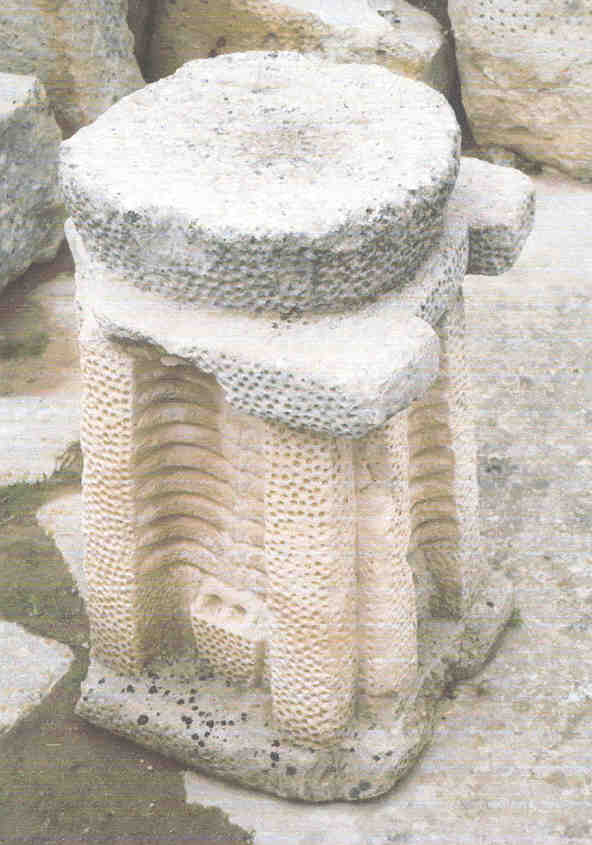 As we now know, the Tree of Life is a universal symbol throughout the ancient
As we now know, the Tree of Life is a universal symbol throughout the ancientworld.5 The oldest representation of the four trees is on a pillar-altar at the temple Hagar Qim, Malta (see Figure 2 left) No one knows for sure who settled Malta, but it is interesting to note that each of the sides of the four-sided pillar has a tree growing out of a pot. This was carved at the time of the first Sumerian
cities in Mesopotamia, and the Sumerians frequently showed the Tree of Life growing from a pot (some Mesoamerican depictions of World Trees spring from a bowl or pot).
Several scholars suggest these trees on the four-sided pillar at Malta represent the four quadrants of the earth at creation. In fact, the four projections on the corners are similar to ancient Israelite incense altars. The King James version of the Bible calls them “horns” but, according to John Tvedtnes and other scholars, known examples are really projections at the four corners.6
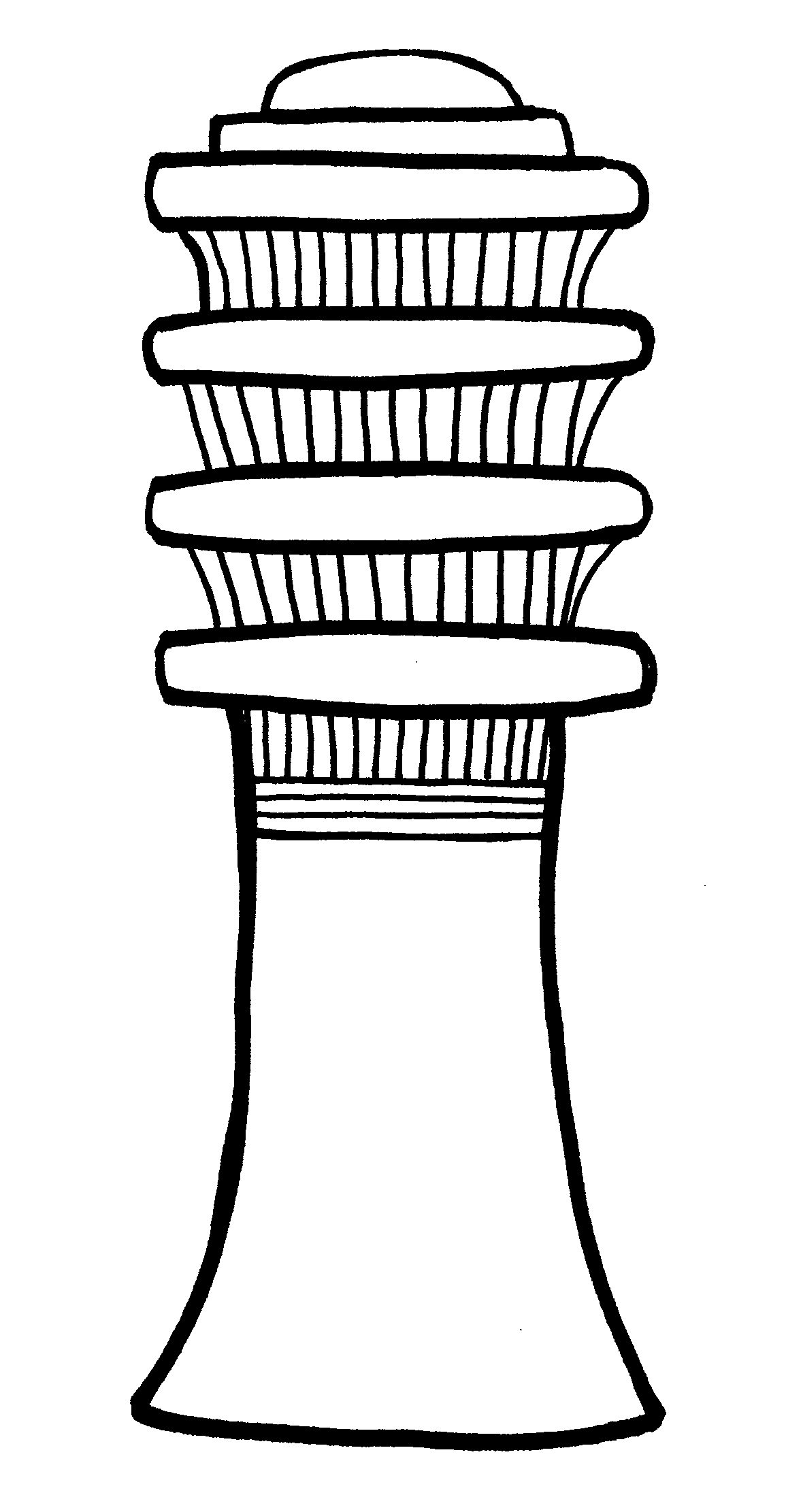
Another tradition that is very old comes to us from Egypt (see Figure 3 at right). The Djed, a symbol of Osiris, also personified the idea of four trees at the corners of the cosmos. It has been suggested the four horizontal lines on the Djed column may represent the branches of a tree, which are now portrayed as sawed off. Legend has it that these four branches were originally turned to the four cardinal directions, the Djed itself representing a pillar of the sky.7
The Palace of Nimrod in Assyria (865 BC) had a relief of the Tree of Life repeated in all four corners of the throne room of King Ashurnasirpal II.8 Each tree was surmounted by a winged sun disc with pennated bird-tail. This last feature, the bird element, will be significant to this discussion when looking at Mesoamerica.
In later Jewish rabbinical literature, which perceptions may have been taken from earlier manuscripts or oral traditions, there is an account of every corner of the Garden of Eden having eighty species of splendid trees. The Tree of Life is in the center with its branches covering the whole of paradise.9 This grouping of trees at the corners of Paradise is impressive when considering this concept.
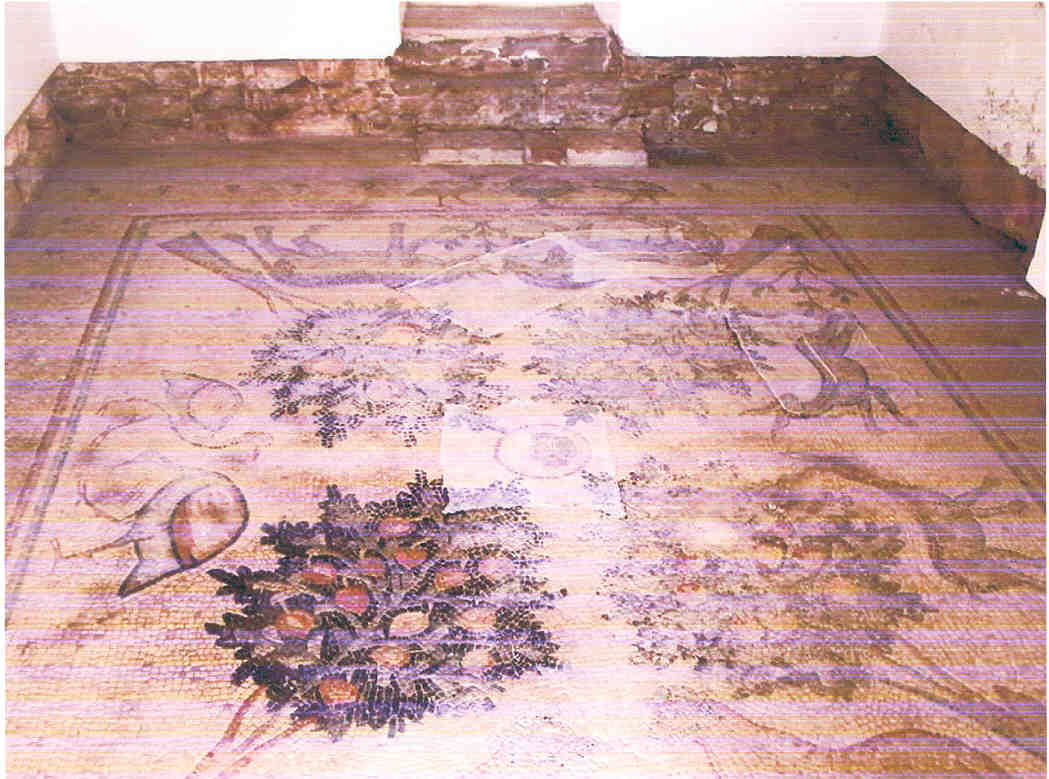
Significantly, there is a mosaic floor representing the four trees in the corners of Paradise in a house in Madaba, Jordan (see Figure 4). At the center of the trees is the head of Adam, the first man in Paradise. The mosaic is from the Byzantine era and similar mosaics of this theme are in the Apostles Church in Mandaba. Where did they get this concept, if not from a manuscript or from oral traditions?
There is even a tale of the founding of Ireland how fruit trees were planted at the four corners of Ireland by a giant who came from the Otherworld (the heavens). This legend also tells of a sacred tree that grew at the center of the four trees at the quadrants.10
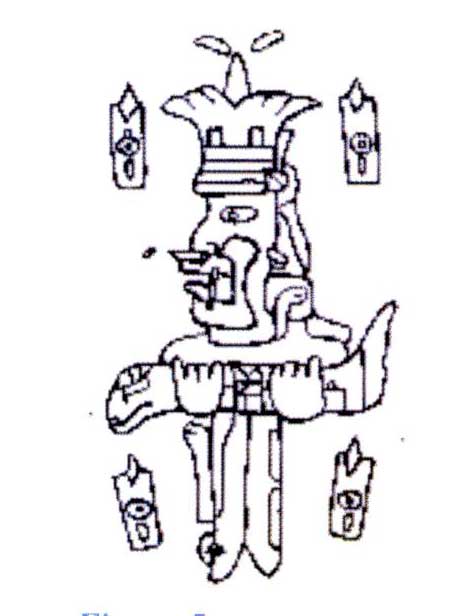 Our attention now turns to Mesoamerica. The earliest pre- Columbian representation dealing with this subject is a jade celt from Veracruz, Mexico, made by the Olmec (see Figure 5 at right). In order to understand the meaning of this design, it is important to know that World Trees could be depicted in Mesoamerica as any number of trees and plants, including a maize plant. A prime example can be seen at the Temple of the Foliated Cross in Palenque, which is clearly a maize plant depicted as the World Tree. The Olmec celt in Figure 5 was created nearly a thousand years earlier than the Foliated Tree/Cross, and has four maize seeds at the cardinal points with the King in the middle who represents the World Tree of the center.11
Our attention now turns to Mesoamerica. The earliest pre- Columbian representation dealing with this subject is a jade celt from Veracruz, Mexico, made by the Olmec (see Figure 5 at right). In order to understand the meaning of this design, it is important to know that World Trees could be depicted in Mesoamerica as any number of trees and plants, including a maize plant. A prime example can be seen at the Temple of the Foliated Cross in Palenque, which is clearly a maize plant depicted as the World Tree. The Olmec celt in Figure 5 was created nearly a thousand years earlier than the Foliated Tree/Cross, and has four maize seeds at the cardinal points with the King in the middle who represents the World Tree of the center.11
Moving on to the Late Pre-Classic in Mesoamerica, approximately 200-100 BC are the incredible murals at San Bartolo, Guatemala. These murals depict the Maya creation myth, including the four trees which represent the four cardinal directions of the cosmos at the beginning of creation. There is also a fifth World Tree that represents the center or axis mundi. Each tree is surmounted by a celestial bird.
At Chichen Itza, which flourished around AD 900 – 1200, there is a much later depiction of four World Trees on the Temple of the Wall Panels on the south exterior wall.12 There are birds atop the trees, which also appeared hundreds of years earlier at San Bartolo. The bird motif atop the Tree of Life was also prevalent in the Old World, especially in Assyria as previously noted.
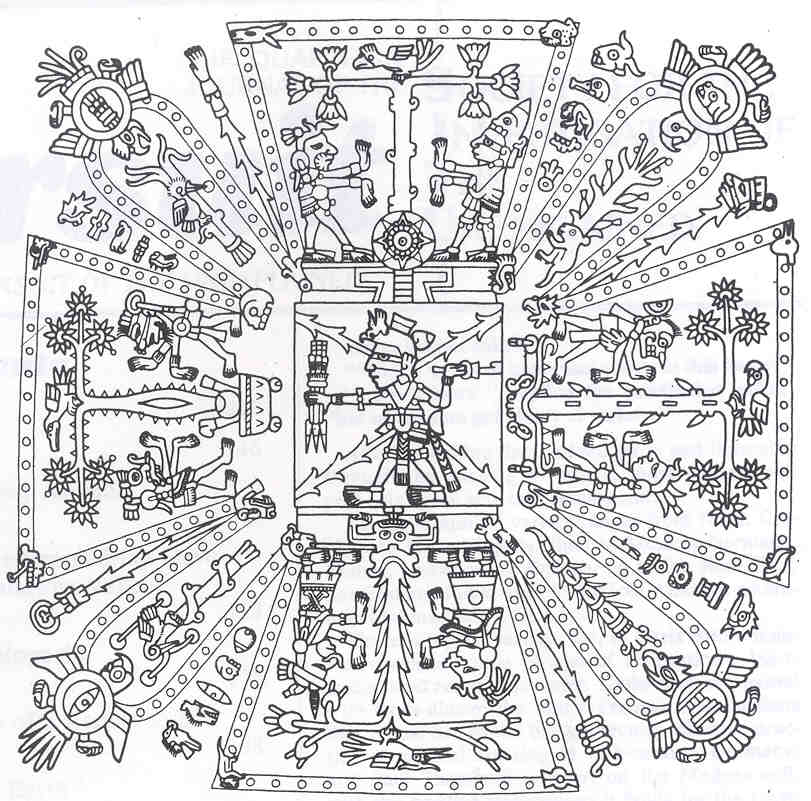 Likewise, the same idea appears a few hundred years later in the Dresden Codex, where the Maya show the rising of the World Trees at the corners of the cosmos. In the Codex Fejervary-Mayer, there is a representation of the four directional trees made by the pre- Columbian Mixtec of Mexico (see Figure 6 at right). This codex shows four World Trees oriented to the four directions, with birds perched at their tops. Alfredo López Austin, who has studied the myth of Paradise in Mesoamerica,
Likewise, the same idea appears a few hundred years later in the Dresden Codex, where the Maya show the rising of the World Trees at the corners of the cosmos. In the Codex Fejervary-Mayer, there is a representation of the four directional trees made by the pre- Columbian Mixtec of Mexico (see Figure 6 at right). This codex shows four World Trees oriented to the four directions, with birds perched at their tops. Alfredo López Austin, who has studied the myth of Paradise in Mesoamerica,
Tamoanchan, explains pre-Columbian thought as expressed in their codices (books):
Regarding the Tree of Life, one has to ask, “How did the concept of a Tree of Life at the center of the World, become established throughout cultures of the world who never read
The Tamoanchan tree was the synthesis of the four trees, and was itself the axis of the universe. At the same time, Tamoanchan was the conjunction of the five cosmic trees. Tamoanchan was one; Tamoanchan was also four, one at each corner of the cosmos. Tamoanchan was also five, the sum total of the cosmic axis and of its four projections.13
Illustrations:
Figure 1: Illustration of Four Rivers in Paradise, Zwiefalten Monastery, Germany
Figure 2: Pillar Four-Sided Altar with Trees from Hagar Qim, Malta (photo by Andress Neumann)
Figure 3: Egyptian Djed amulet, symbol of Osiris.
Figure 4: Mosaic floor of the four trees of Paradise in Mandaba, (http://traveladventures.org/continents/asia/madabamosiac01.shtml).
Figure 5: Incised Olmec celt from Arroyo Pesquero, Veracruz, Mexico (redrawn after Reilly 1996: 38, Fig. 25).
Figure 6: Four trees at the Cardinal Directions, in the Codex Fejervary-Mayer.
Footnotes:
1 Louis Ginzberg, The Legends of the Jews (Philadelphia: The Jewish Publication Society of America) 1937, Vol. I, 70.
2 See http://www.nationmaster.com/encyclopedia/Earthly-Paradise
3 Milton R. Hunter, Pearl of Great Price Comentary (Salt Lake City: Bookcraft, 1951), 108.
4 Karen Bassie-Sweet, Maya Sacred Geography and the Creator Gods (Norman: University of Oklahoma Press) 2008: 239.
5 See Roger Cook, The Tree of Life (New York: Avon Books, a division of The Hearst Corporation, 1974).
6 Personal communication from John Tvedtnes, January 19, 2009.
7 Carol Andrews, “Ancient Egyptian Funerary Amulets: Protection, Power and Patronage.” Paper presented at the Annual American Research Center in Egypt Symposium, jointly sponsored by the Brooklyn Museum, December 4, 1993.
See Also E. A. Wallis Budge, The Gods of the Egyptians (London: Methuen & Company, 1904; reprint, New York: Dover Publications, 1969), Vol. 2:125.
8 Dominique Collon, Ancient Near Eastern Art (Berkeley & Los Angeles: University of California Press, 1995), 132-133.
9 Angelo S. Rappoport, Ancient Israel: Myths and Legends (New York: Crown Publishers, 1987), Vol. I:119.
10 http://www.chalicecentre.net/celtictreeoflife.htm
11 Kent Reilly, “Art, Ritual, and Rulership in the Olmec World,” in The Olmec World: Ritual and Rulership (Princeton: The Art Museum, Princeton University, 1995), 39. For the King and the Tree symbolism, see Diane E. Wirth, Mesoamerican and Ancient Middle Eastern Traditions (St. George, Utah: Stonecliff Publishing, 2003), 94-115.
12 Karl Ruppoert, “The Temple of the Wall Panels, Chichen Itza,” in Carnegie Institution of Washington, Vol. I, November 1931, Plate 11b.
13 Alfredo López Austin, Tamoanchan, Tlalocan: Places of Mist (Niwot, Colorado: University Press of Colorado, 1997), 116.


